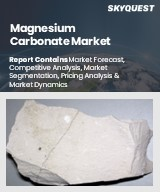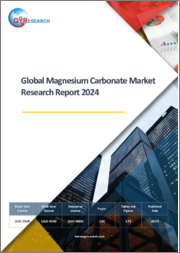
|
시장보고서
상품코드
1789258
탄산마그네슘 시장 규모, 점유율, 성장 분석 : 제품별, 용도별, 등급별, 지역별 - 산업 예측(2025-2032년)Magnesium Carbonate Market Size, Share, and Growth Analysis, By product (Heavy Magnesium Carbonate, Light Magnesium Carbonate), By application, By Grade, By Region - Industry Forecast 2025-2032 |
||||||
세계의 탄산마그네슘 시장 규모는 2023년에 2억 8,070만 달러로 평가되며, 2024년 3억 4,000만 달러에서 2032년에는 5억 1,468만 달러로 성장하며, 예측 기간(2025-2032년)의 CAGR은 4.7%로부터 6.5%로 성장할 전망입니다.
세계의 탄산마그네슘 시장은 제약, 플라스틱, 고무, 화장품, 제지, 건설 등 다양한 산업에서의 사용 증가로 인해 괄목할 만한 성장세를 보이고 있습니다. 내열성, 흡수성, 안정제 및 증량제 역할 등 유리한 화학적, 물리적 특성이 이러한 추세에 크게 기여하고 있습니다. 의약품에서는 제산제 및 완하제로 널리 사용되고 있으며, 특히 고령화 사회에서 증가하는 위장장애에 대응하고 있습니다. 또한 플라스틱이나 고무에서는 제품의 강도와 내구성을 높이는 중요한 충전재로 사용되고 있습니다. 아시아태평양은 효율적인 생산 능력으로 중국과 인도를 필두로 시장을 독점하고 있으며, 북미와 유럽은 주로 일관된 의약품 수요에 의해 주도되고 있습니다. 그러나 채굴과 폐기물 관리를 둘러싼 엄격한 규제가 과제가 되고 있으며, 현재 진행 중인 기술 발전과 지속가능성에 대한 중요성이 시장의 꾸준한 성장을 가속할 것으로 예측됩니다.
목차
서론
- 조사의 목적
- 조사 범위
- 정의
조사 방법
- 정보 조달
- 2차와 1차 데이터 방법
- 시장 규모 예측
- 시장의 전제조건과 제한
개요
- 세계 시장 전망
- 공급과 수요 동향 분석
- 부문별 기회 분석
시장 역학과 전망
- 시장 개요
- 시장 규모
- 시장 역학
- 촉진요인과 기회
- 억제요인과 과제
- Porter의 산업 분석
주요 시장 인사이트
- 주요 성공 요인
- 경쟁의 정도
- 주요 투자 기회
- 시장 에코시스템
- 시장의 매력 지수(2024년)
- PESTEL 분석
- 거시경제 지표
- 밸류체인 분석
- 가격 분석
- 사례 연구
- 고객 구매 행동 분석
탄산마그네슘 시장 규모 : 제품별, CAGR(2025-2032년)
- 시장 개요
- 중탄산마그네슘
- 경탄산마그네슘
탄산마그네슘 시장 규모 : 용도별, CAGR(2025-2032년)
- 시장 개요
- 화학 합성
- 퍼스널케어·화장품
- 페인트·잉크
- 플라스틱·고무
- 펄프·제지
- 첨가제·충전제
- 제산제
탄산마그네슘 시장 규모 : 등급별, CAGR(2025-2032년)
- 시장 개요
- 의약품 등급
- 식품 등급
- 산업 등급
탄산마그네슘 시장 규모 : 지역별, CAGR(2025-2032년)
- 북미
- 미국
- 캐나다
- 유럽
- 독일
- 스페인
- 프랑스
- 영국
- 이탈리아
- 기타 유럽 지역
- 아시아태평양
- 중국
- 인도
- 일본
- 한국
- 기타 아시아태평양
- 라틴아메리카
- 브라질
- 기타 라틴아메리카 지역
- 중동 및 아프리카
- GCC 국가
- 남아프리카공화국
- 기타 중동 및 아프리카
경쟁 정보
- 상위 5사의 비교
- 주요 기업의 시장 포지셔닝(2024년)
- 주요 시장 기업이 채택한 전략
- 최근 시장 동향
- 기업의 시장 점유율 분석(2024년)
- 주요 기업의 기업 개요
- 기업의 상세
- 제품 포트폴리오 분석
- 기업의 부문별 점유율 분석
- 매출의 전년대비 비교(2022-2024년)
주요 기업 개요
- Merck KGaA
- Sigma-Aldrich
- Lhoist Group
- Graymont Ltd
- Shinko Kogyo
- Specialty Minerals Inc.
- Omya Group
- SCR-Sibelco N.V.
- Konoshima Chemical Co. Ltd.
- Kyowa Chemical Industry Co. Ltd.
- Yingkou Magnesite Chemical
- SCORA S.A.S
- Buschle & Lepper S.A.
- Lehmann&Voss&Co.
결론과 제안
KSA 25.08.20Global Magnesium Carbonate Market size was valued at USD 280.7 Million in 2023 and is poised to grow from USD 340 Million in 2024 to USD 514.68 Million by 2032, growing at a CAGR of 4.7% to 6.5% in the forecast period (2025-2032).
The global magnesium carbonate market is experiencing notable growth, driven by its increasing application across diverse industries including pharmaceuticals, plastics, rubber, cosmetics, paper, and construction. Its advantageous chemical and physical properties, such as heat resistance, absorbency, and roles as a stabilizer and bulking agent, significantly contribute to this trend. In pharmaceuticals, it is widely used as an antacid and laxative, catering to the rising prevalence of gastrointestinal disorders, particularly among the aging population. Additionally, in plastics and rubber, it serves as a vital filler that enhances product strength and durability. The Asia-Pacific region dominates the market, spearheaded by China and India, owing to their efficient production capabilities, while North America and Europe follow, driven primarily by consistent pharmaceutical demands. However, stringent regulations surrounding mining and waste management pose challenges, yet ongoing technological advancements and a focus on sustainability are expected to foster steady growth in the market.
Top-down and bottom-up approaches were used to estimate and validate the size of the Global Magnesium Carbonate market and to estimate the size of various other dependent submarkets. The research methodology used to estimate the market size includes the following details: The key players in the market were identified through secondary research, and their market shares in the respective regions were determined through primary and secondary research. This entire procedure includes the study of the annual and financial reports of the top market players and extensive interviews for key insights from industry leaders such as CEOs, VPs, directors, and marketing executives. All percentage shares split, and breakdowns were determined using secondary sources and verified through Primary sources. All possible parameters that affect the markets covered in this research study have been accounted for, viewed in extensive detail, verified through primary research, and analyzed to get the final quantitative and qualitative data.
Global Magnesium Carbonate Market Segments Analysis
The magnesium carbonate market is segmented into product, application, grade, and region. By product, the market is classified into heavy magnesium carbonate, light magnesium carbonate. Depending on the application, it is divided into chemical synthesis, personal care and cosmetics, paints and inks, plastic and rubber, pulp and paper,additive & filler, antacid. According to grade, the market is categorized into pharma, food, industrial. Regionally, it is analyzed across North America, Europe, Asia-Pacific, Latin America, and the Middle East & Africa.
Driver of the Global Magnesium Carbonate Market
The increasing prevalence of digestive disorders and a growing awareness of health and wellness are major contributors to the rising demand for magnesium carbonate, particularly in antacids and dietary supplements. As more consumers seek effective solutions for digestive health, products like antacids gain popularity. In addition, the ongoing growth of the pharmaceutical industry significantly supports this market, particularly in regions such as North America and Asia-Pacific. The combination of a heightened focus on personal health and the robust expansion of related industries positions magnesium carbonate as an essential ingredient in various health-related products, driving its market potential further.
Restraints in the Global Magnesium Carbonate Market
The Global Magnesium Carbonate market faces significant challenges due to stringent regulatory frameworks that impose considerable compliance obligations on manufacturers. Such regulations necessitate substantial investments in sustainable extraction methods and effective dust control measures, which can strain resources and limit the ability to scale production, particularly within European regions. These constraints may hinder growth potential and elevate operational costs for companies striving to meet these regulatory standards. Consequently, manufacturers must navigate complex compliance landscapes while balancing the need for innovation and environmental responsibility, impacting their overall competitiveness in the global market.
Market Trends of the Global Magnesium Carbonate Market
The global magnesium carbonate market is experiencing significant growth driven by its diverse applications in the pharmaceuticals and personal care sectors. With rising health consciousness among consumers and an increase in gastrointestinal disorders, magnesium carbonate is increasingly utilized as an antacid, filler, and laxative in various pharmaceutical formulations. Additionally, its properties as an absorbent enhance its appeal in personal care products. As the pharmaceutical market expands, the demand for magnesium carbonate is expected to follow suit, highlighting a notable trend of increased adoption across health-related industries, further solidifying its position as a vital component in a broad range of applications.
Table of Contents
Introduction
- Objectives of the Study
- Scope of the Report
- Definitions
Research Methodology
- Information Procurement
- Secondary & Primary Data Methods
- Market Size Estimation
- Market Assumptions & Limitations
Executive Summary
- Global Market Outlook
- Supply & Demand Trend Analysis
- Segmental Opportunity Analysis
Market Dynamics & Outlook
- Market Overview
- Market Size
- Market Dynamics
- Drivers & Opportunities
- Restraints & Challenges
- Porters Analysis
- Competitive rivalry
- Threat of substitute
- Bargaining power of buyers
- Threat of new entrants
- Bargaining power of suppliers
Key Market Insights
- Key Success Factors
- Degree of Competition
- Top Investment Pockets
- Market Ecosystem
- Market Attractiveness Index, 2024
- PESTEL Analysis
- Macro-Economic Indicators
- Value Chain Analysis
- Pricing Analysis
- Case Studies
- Customer Buying Behavior Analysis
Global Magnesium Carbonate Market Size by Product & CAGR (2025-2032)
- Market Overview
- Heavy Magnesium Carbonate
- Light Magnesium Carbonate
Global Magnesium Carbonate Market Size by Application & CAGR (2025-2032)
- Market Overview
- Chemical Synthesis
- Personal Care and Cosmetics
- Paints and Inks
- Plastic and Rubber
- Pulp and Paper
- Additive & Filler
- Antacid
Global Magnesium Carbonate Market Size by Grade & CAGR (2025-2032)
- Market Overview
- Pharma
- Food
- Industrial
Global Magnesium Carbonate Market Size & CAGR (2025-2032)
- North America (Product, Application, Grade)
- US
- Canada
- Europe (Product, Application, Grade)
- Germany
- Spain
- France
- UK
- Italy
- Rest of Europe
- Asia Pacific (Product, Application, Grade)
- China
- India
- Japan
- South Korea
- Rest of Asia-Pacific
- Latin America (Product, Application, Grade)
- Brazil
- Rest of Latin America
- Middle East & Africa (Product, Application, Grade)
- GCC Countries
- South Africa
- Rest of Middle East & Africa
Competitive Intelligence
- Top 5 Player Comparison
- Market Positioning of Key Players, 2024
- Strategies Adopted by Key Market Players
- Recent Developments in the Market
- Company Market Share Analysis, 2024
- Company Profiles of All Key Players
- Company Details
- Product Portfolio Analysis
- Company's Segmental Share Analysis
- Revenue Y-O-Y Comparison (2022-2024)
Key Company Profiles
- Merck KGaA
- Company Overview
- Business Segment Overview
- Financial Updates
- Key Developments
- Sigma-Aldrich
- Company Overview
- Business Segment Overview
- Financial Updates
- Key Developments
- Lhoist Group
- Company Overview
- Business Segment Overview
- Financial Updates
- Key Developments
- Graymont Ltd
- Company Overview
- Business Segment Overview
- Financial Updates
- Key Developments
- Shinko Kogyo
- Company Overview
- Business Segment Overview
- Financial Updates
- Key Developments
- Specialty Minerals Inc.
- Company Overview
- Business Segment Overview
- Financial Updates
- Key Developments
- Omya Group
- Company Overview
- Business Segment Overview
- Financial Updates
- Key Developments
- SCR-Sibelco N.V.
- Company Overview
- Business Segment Overview
- Financial Updates
- Key Developments
- Konoshima Chemical Co. Ltd.
- Company Overview
- Business Segment Overview
- Financial Updates
- Key Developments
- Kyowa Chemical Industry Co. Ltd.
- Company Overview
- Business Segment Overview
- Financial Updates
- Key Developments
- Yingkou Magnesite Chemical
- Company Overview
- Business Segment Overview
- Financial Updates
- Key Developments
- SCORA S.A.S
- Company Overview
- Business Segment Overview
- Financial Updates
- Key Developments
- Buschle & Lepper S.A.
- Company Overview
- Business Segment Overview
- Financial Updates
- Key Developments
- Lehmann&Voss&Co.
- Company Overview
- Business Segment Overview
- Financial Updates
- Key Developments











